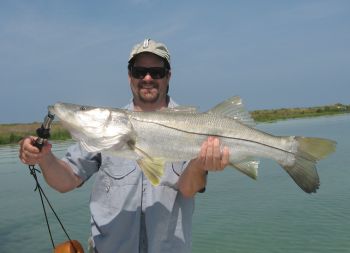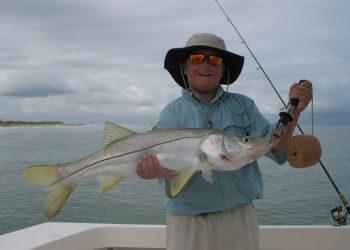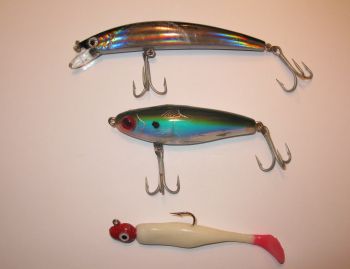 Each spring, as Tampa Bay waters begin to warm, anticipation builds among inshore anglers. They know that when temperatures hit the 70 degree mark, snook will move to the beaches and the spring bite will be on. Exactly when these fish move out of the backwaters or in from near shore reefs will vary from year to year, but it’s sure to happen somewhere between
Each spring, as Tampa Bay waters begin to warm, anticipation builds among inshore anglers. They know that when temperatures hit the 70 degree mark, snook will move to the beaches and the spring bite will be on. Exactly when these fish move out of the backwaters or in from near shore reefs will vary from year to year, but it’s sure to happen somewhere between
late April and Early May. Fishing “on the outside” typically lasts through the summer and into October, although May, June and early July are clearly prime time.Why all the excitement? There are a number of reasons. Beach snook generally feed more aggressively than snook in any other location as they are fattening up for their summer spawn. They tend to gather in groups and are easy to spot over the mostly white sand bottoms. Also, there is little structure for these fish to break off on, so the odds of both hooking and landing multiple snook is better at this time of year than any other…and there are some BIG fish available. Add to that the beautiful beach scenery…azure green water and white sand…and it doesn’t get much better.
There are a number of ways to catch these fish…the most common being the use of live “whitebait”, or pilchards. These baits are cast-netted early in the morning of your fishing day, typically on shallow grass flats adjacent to one of our numerous passes. More is better and having a live well of over a thousand whitebaits will allow you to chum liberally, which can often trigger a bite on fish that aren’t initially active. Other very effective baits, especially for larger snook, are threadfin herring, grass grunts and smaller ladyfish. The threadfins can also be netted, where the grass grunts and ladyfish are typically secured through the use of hook and line. Once baited up, it’s time to catch fish. A major consideration when snook fishing is tidal movement. Although fish can be caught on weak tides, fishing is greatly improved during strong tidal movement…and it makes sense. Fish are posted up waiting for dinner to be served and once that tide starts to move, more bait fish pass overhead as the current sweeps them by. As a result, these fish “turn on”. Incoming tides can be good, outgoing tides seem to be even better so, when planning your snook fishing trips, target days with strong outgoing tides as this will heighten your chances of success. Also, when you begin hooking fish, carefully note the “tide time”…exactly how long after the previous high or low tide it is…as fish will likely feed at the same tide time the next day.
 Fish can be spotted in many of the swash channels that run parallel to the beach, both in groups and swimming along solo but the highest probability locations for finding these “linesiders” are the deep cuts at the ends of our inter-coastal islands. Anywhere that a pass cuts through to the ocean, rest assured that here are numerous snook around. In close proximity to the ends of all of these islands, there will be a channel that is markedly deeper than the surrounding water. This is typically the result of tidal currents that run close to these islands. Like trout in a river, snook will lay along the bottom in this deeper water waiting for the current to bring them dinner. If it’s not too deep, and you have a good pair of polarized glasses, you may be able to see a dark mass of snook holding close to the bottom. If you cannot see the fish, assume that they are in the deepest past of the run and present your baits accordingly.
Fish can be spotted in many of the swash channels that run parallel to the beach, both in groups and swimming along solo but the highest probability locations for finding these “linesiders” are the deep cuts at the ends of our inter-coastal islands. Anywhere that a pass cuts through to the ocean, rest assured that here are numerous snook around. In close proximity to the ends of all of these islands, there will be a channel that is markedly deeper than the surrounding water. This is typically the result of tidal currents that run close to these islands. Like trout in a river, snook will lay along the bottom in this deeper water waiting for the current to bring them dinner. If it’s not too deep, and you have a good pair of polarized glasses, you may be able to see a dark mass of snook holding close to the bottom. If you cannot see the fish, assume that they are in the deepest past of the run and present your baits accordingly.
By using light tackle to pursue these fish, you’ll heighten your enjoyment and also increase your odds of hooking fish. Daiwa’s 7.5 foot medium action Saltiga spinning rod is a perfect choice for this fishing. Match this with A Daiwa 3000 or a Shimano Symetre 4000 reel, spooled with 20 lbs braided line and your ready to go. Always use fluorocarbon leader as this product is less visible to the fish…important when fishing these clear waters. Thirty pound test will usually land the largest snook you are likely to hook but if the fish are finicky, you might drop as low as twenty. Although snook do not have large, sharp teeth, they are equipped with small teeth that work like sandpaper on your leader. During extended fights with big fish, your leader may fail just as your prize is coming within reach when using leader material lighter than 30 pound test. There is one other important consideration when tying on your leader. Make sure it is long…five or six feet. You will be fishing in very shallow, clear water. This longer leader will improve your chances of hooking these sometimes, line shy fish. Hook size is dependent more or bait size than on the fish you are pursuing. If smaller whitebait is all that is available, you might use a #1/0 or #2/0 hook. If you were able to secure large whitebait (5 inches), grunts or ladyfish, a #3/0 or #4/0 hook might be more appropriate. As snook are highly protected and must often be released (View Current Fishing Regulations ), always use circle hooks when fishing live bait. Nine times out of ten times, these hooks will lodge in the corner of the fish’s mouth, insuring a quick release and an unharmed fish. Should you need information on which knots to use when rigging for snook, click here.
As in many types of fishing, having the right bait and presenting it properly is the key to success. Snook expect naturally moving bait and will often shy away from one that is acting peculiar. This being the case, all baits are normally presented with no weight, are cast “up-tide” of where the snook are, and are drifted through the target zone with no resistance so that they appear to be swimming freely. You may need to mend your line or feed out additional line so that your bait passes through the strike zone in a totally natural fashion. Although fish will, from time to time, charge these baits, provide a violent strike and hook themselves, this is not always the case. Oftentimes, these fish will rise up off the bottom as your offering is going over head, inhale it and sink back down to the to wait for their next meal. What this translates to on the angler’s end of the line is a distinct “tick”, which is when the fish actually inhales the bait. Obviously, the forward progress of your bait will have ceased as well. If either of these things happen, simply reel down until you are tight on the fish and set the hook. With circle hooks, simply the act of reeling down will usually set the hook, so a moderate hook set is really all that’s needed. A strong hook set at the same time the snook is just starting to take off can result in a broken line. All hookups are followed by a powerful, fast run and usually a few jumps sprinkled in. Most snook are lost during this initial run or right at boat- side, so remember that when the fish is going crazy in the first minute or so of the fight, you need to be very calm. If the fish wants to take a long run, just let him go, but make sure to keep a good bend in your rod by maintaining constant pressure. Do not try and reel while a fish is pulling drag.
If fishing to visible fish in the swash channels along the beach, you’ll likely encounter two scenarios. The first is a group of stationary fish. In this case, cast an un-weighted whitebait to the edge of this group. If there is any current in the area, make sure to cast up-tide. If the fish are active, one will almost always charge out and eat it. If not, throw directly into the group, and hope that they don’t scatter.  Sometimes a bait swimming right under their noses triggers a response. There are certainly times when these fish simply refuse to eat. The key to telling whether or not they will ultimately eat is by watching their movements. If they ignore your bait and stay in the same place, they may eat. If they move away from your bait when it lands near them, your odds a catching a fish are less. If the group of fish starts to move off and you almost feel like you are chasing them, well, you are and the odds of hooking a fish are way against you here. Go find another group of fish. The second scenario is where you spot one a single fish or small group of fish moving down the shoreline. Typically these fish will be within five to ten feet of the shore. Obviously, you are going to want to present your bait well out in front of these moving fish…maybe fifteen to twenty feet. There is no need to risk spooking them by casting too close. These fish will either rush your bait when they see it, go over and give it a sniff or nudge and maybe eat it, or not, or swing wide of your bait when the get close to it and speed up to get away from it. Usually, you are going to get only a cast or two at fish like this. Although these “swash fish” may be a little smaller, on average, than the fish found in the cuts, seeing a snook blast a bait in two feet of gin clear water is very exciting so fishing these swashes can be highly entertaining. One other tactic you might try, whether fishing to a group or to an individual fish, is to cast your bait almost onto the shore. Snook seem to like a bait coming off of the beach; probably because they know that they can trap it against the sand and therefore have a higher probability of catching it. Again, this is where using a long leader is helpful. If a snook sees your line in shallow water, it will often spook. By casting up to the shore, there is a much greater chance that the fish will swim near or under your line, and if they do, you want it to be fluorocarbon as they’re less likely to see it.
Sometimes a bait swimming right under their noses triggers a response. There are certainly times when these fish simply refuse to eat. The key to telling whether or not they will ultimately eat is by watching their movements. If they ignore your bait and stay in the same place, they may eat. If they move away from your bait when it lands near them, your odds a catching a fish are less. If the group of fish starts to move off and you almost feel like you are chasing them, well, you are and the odds of hooking a fish are way against you here. Go find another group of fish. The second scenario is where you spot one a single fish or small group of fish moving down the shoreline. Typically these fish will be within five to ten feet of the shore. Obviously, you are going to want to present your bait well out in front of these moving fish…maybe fifteen to twenty feet. There is no need to risk spooking them by casting too close. These fish will either rush your bait when they see it, go over and give it a sniff or nudge and maybe eat it, or not, or swing wide of your bait when the get close to it and speed up to get away from it. Usually, you are going to get only a cast or two at fish like this. Although these “swash fish” may be a little smaller, on average, than the fish found in the cuts, seeing a snook blast a bait in two feet of gin clear water is very exciting so fishing these swashes can be highly entertaining. One other tactic you might try, whether fishing to a group or to an individual fish, is to cast your bait almost onto the shore. Snook seem to like a bait coming off of the beach; probably because they know that they can trap it against the sand and therefore have a higher probability of catching it. Again, this is where using a long leader is helpful. If a snook sees your line in shallow water, it will often spook. By casting up to the shore, there is a much greater chance that the fish will swim near or under your line, and if they do, you want it to be fluorocarbon as they’re less likely to see it.
Snook will respond well to artificial baits on some occasions. Along the beach, jigs are very effective. White marabou or white plastic swim tail jigs on a ¼ ounce head seem to work the best. If fishing during lower light hours or at night, glow in the dark swim tails can be very good. Minnow imitating plugs made by the likes of Mirrolure and Yozuri can also get the job done. With all of these lures, remember that, if fish are visible, it’s always best to not have your retrieve approaching the fish, but angling away. 
Many anglers have spent long hours with little reward when pursuing snook and, as a result, this fish has developed a reputation for being very “smart”. The reality is that snook have very defined feeding periods. For twenty three hours and a half hours a day, they may be one of the toughest fish to catch, but be on a group of snook during one of their fifteen minute feeding sprees, and they may appear downright easy to catch. By putting the right bait in your well, knowing where the fish are and being there at the right phase of the tide, you too can experience a snook fishing bonanza.
